Four Chinese rhinoceros horn libation cups & a German rhinoceros horn goblet at Bonhams HK, 27 november 2018
Lot 87. An exceptionally rare and very large rhinoceros horn 'three-dragons and grapevine' wine receptacle, 17th-18th century; 19cm (7 1/2in) long. Estimate: HK$1,200,000.00 - HK$1,500,000.00 (€ 90,000 - 130,000). Unsold. © Bonhams.
Boldly carved as a very large cup-shaped vine leaf emanating from thick twisting branches issuing further vines, tendrils and clusters of luscious juicy grapes skillfully carved in high relief, interspersed with three powerfully writhing dragons, each with incised manes, flaring nostrils and bulging eyes, the horn of dark-chocolate tone.
Provenance: An important European private collection of rhinoceros horn carvings, and thence by descent.
Published and Illustrated: J.Chapman, The Art of Rhinoceros Horn Carving in China, London, 1999, pp.62 and 91, figs.32 and 72.
Note: The present rhinoceros horn wine receptacle is exceptionally rare and is one of the largest of its type; in the words of Jan Chapman it is '...the largest bowl I have yet seen. It is almost certainly a wine container - the clue lying in the luscious grapes which decorate the exterior.'; see J.Chapman, The Art of Rhinoceros Horn Carving in China, London, 1999, p.91. This remarkable vessel is noteworthy for the bold high-relief carving of the juicy grapes, large vine leaves and three ferocious dragons.
Grapes, introduced to China from Central Asia, became popular as a decorative motif in Chinese works of art during the Tang dynasty, as can be seen in bronze mirrors, due to trade and cultural outreach at the time. It re-appeared again in the Yuan dynasty, most likely for similar reasons and continued into the early Ming period, as can be attested by the decoration on blue and white porcelain. By the late Ming period, grapes had proliferated enough for even the poor scholar Xu Wei 徐渭 (1521-1593) to write and paint them on China's south-east coast. In his poem inscribed on a painting of grapes, Xu wrote: 'Pearls from my pen find no buyer' 筆低明珠無處賣, making it clear that grapes likened to treasured pearls, could be used as a metaphor for talent (appreciated or not). The second half of the 17th century saw greater proliferation of this motif, though shown with squirrels and not dragons, as can be seen in porcelain vessels.
The imagery between dragons and pearl-like grapes and the wine they produced was established earlier however, by the Tang poet Li He 李賀 (790-816) in his well known poem, 'Bring in the Wine!' (將進酒):
琉璃鐘,琥珀濃,小槽酒滴真珠紅。
烹龍炮鳳玉脂泣,羅幃繡幕圍香風。
'Glazed goblet filled with thick amber liquid, little drops of wine truly like red pearls.
Dragons brewing and phoenix boiling tears of lard-like jade, the fragrance encircling the embroidered silk gauze curtain'.
The poem likens the act of heating red-grape wine as to dragons and phoenixes brewing a fragrant elixir. This imagery may have inspired the master carver of the present rhinoceros horn cup as well as those drinking from it.
Rhinoceros horn cups decorated with dragons and grapes are very rare; see, however, a related rhinoceros horn cup carved with grapes, illustrated by T.Fok, Connoisseurship of Rhinoceros Horn Carving in China, Hong Kong, 1999, p.158, no.107.
Lot 88. A massive rhinoceros horn goblet, Probably German, 18th century; 18cm (7in) high. Estimate: HK$800,000.00 - HK$1,200,000.00 (€ 90,000 - 130,000). Unsold. © Bonhams.
The imposing vessel of slightly tapering cylindrical form, finely turned with three 'bow-string' bands around the exterior, above a wide band, the lower section with a raised spreading foot, the horn of pale golden-honey tone.
Provenance: An important European private collection of rhinoceros horn carvings, and thence by descent.
Published and Illustrated: J.Chapman, The Art of Rhinoceros Horn Carving in China, London, 1999, p.271, fig.392.
Note: The present lot encapsulates the exchange of ideas and knowledge, particularly in medicine, between China and Europe. It was made in Europe, probably in Germany, to be used as a mortar for grinding of herbs and medicinal compounds. It was perhaps influenced by Chinese beliefs and practices concerning the rumored medicinal use of rhinoceros horn that was seen by European merchants trading in China who witnessed the use of rhinoceros horn powder as a treatment for fever. Indeed, a rhinoceros even forms part of the coat-of-arms of the Worshipful Society of Apothecaries of London. From this, one can infer that rhinoceros horn was perceived in Europe as possessing special medicinal and anti-toxic properties.
Further reinforcing the perceived link in Europe between medicine and rhinoceros horn, is a rhinoceros horn mortar made in Europe, carved with the name of the ancient physician Hippocratos in Greek letters and two snakes, illustrated by J.Chapman, The Art of Rhinoceros Horn Carving in China, London, 1999, p.271, fig.391.
Lot 91. A rare small rhinoceros horn 'Zhang Qian in a Raft' pouring vessel, 17th-18th century; 13cm (5 1/8in) long. Estimate: HK$300,000.00 - HK$500,000.00. (€ 34,000 - 56,000). Unsold. © Bonhams.
Naturalistically carved as a long hollowed log raft tapering at the prow into a spout, elaborately carved in high relief at the centre of the raft with the figure Zhang Qian seated amidst dense branches of flowers and lotus, the figure holding a fly-whisk in his left hand, all above undulating waves carved in low relief on the underside, the horn of an attractive dark honey tone.
Note: The present lot exhibits masterful craftsmanship in the all-round naturalistic execution of the gnarled raft, beautifully capturing the wizened figure of the Han dynasty Imperial envoy and official, Zhang Qian, and displaying whimsical creativity in the depiction of the lotus issuing from the branches. The tip is pierced into a spout, which suggests that the present lot would have been used as a water dropper. Together with the elaborate reticulated carvings of the branches, it would have required scrupulous attention to detail; for a discussion of these raft vessels, see J.Chapman, The Art of Rhinoceros Horn Carving in China, London, 1999, pp.77-80.
The present lot depicts the story of the Han dynasty statesman, traveller and explorer Zhang Qian, floating up the River of Heaven in a log boat to explore the Western Regions (Xiyu 西域). The historical Zhang Qian did in fact play an integral role in establishing an east-west route opening China to the world of commercial trade and major trade routes such as the renowned Silk Road.
This 'Zhang Qian on a raft' pouring vessel belongs to a small group of rhinoceros horn carvings, which are similar in the general form of a hollowed log but with variations in the appearance of the raft and depictions of Zhang Qian who variously holds a book, a ruyi sceptre, a lotus and a fly-whisk. Examples of these Zhang Qian raft vessels are held in important museums and private collections including: one in the National Palace Museum, Taipei, included in the exhibition Jiangxin yu xiangong: Ming Qing diaoke zhan (Uncanny Ingenuity and Celestial Feats: The Carvings of Ming and Qing Dynasties), Taipei, 2011, no.30; three in the Qing Court Collection, illustrated in The Complete Collection of Treasures of the Palace Museum: Bamboo, Wood, Ivory and Rhinoceros Horn Carvings, Hong Kong, 2002, nos.118-120; four in the Chester Beatty Library, Dublin, with one illustrated by J.Chapman, Ibid., pl.47; one in the Shanghai Museum and another in the collection of Harvard University Art Museum, illustrated by T.Fok in Connoisseurship of Rhinoceros Horn Carving in China, Hong Kong, 1999, nos.70 and 71; and two others in private collections, illustrated by T.Fok, Ibid., nos.73 and 74.
This very special group of rhinoceros horn carvings may have been inspired by the well-known silver example formerly in the collection of Lady David, inscribed with a poem and artist's seal Bishan denoting Zhu Bishan, a silversmith active during the 14th century, illustrated in Chinese Art Under the Mongols: The Yuan Dynasty (1279-1368), Cleveland Museum of Art, 1968, no.37.
See a related larger rhinoceros horn log-raft with a carving of Zhang Qian, 17th/18th century, which was sold at Bonhams Hong Kong, 28 November 2017, lot 51.
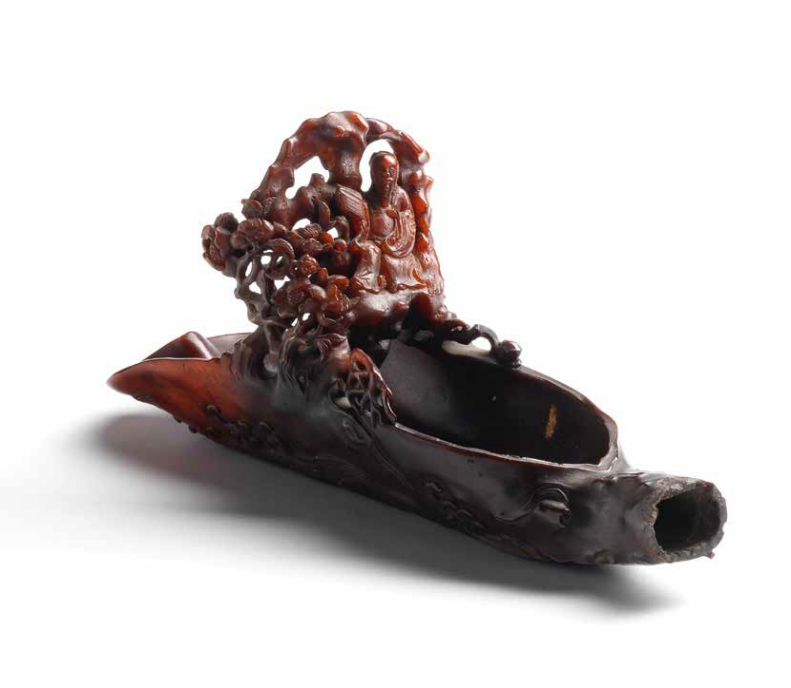
A very rare rhinoceros horn 'Zhang Qian in a raft' pouring vessel, 17th-18th century; 21cm (8 1/4in) long. Sold for HK$ 937,500 (€101,083) at Bonhams Hong Kong, 28 November 2017, lot 51. Photo: Bonhams.
Lot 92. A rhinoceros horn 'scholar and pine' libation cup, 17th-18th century; 15.1cm (5 8/9in) long. Estimate: HK$300,000.00 - HK$500,000.00. (€ 34,000 - 56,000). Unsold. © Bonhams.
Deftly carved around the exterior with a continuous landscape scene of a scholar and young attendant by a rocky bank beside a river with finely incised currents atop which drifts a boat with two oarsmen emerging from under a cliff formed as the handle, beside which another tall and gnarled pine tree carved in high relief rises and branches into the interior, beside further wutong trees and a pavilion, the horn of amber-honey tone.
Provenance: An English private collection.
Note: The exterior of the present lot carved with figures among ancient pines and streams winding around jagged rocks is painterly and imbued with a poetic elegance fully embodying the romantic temperament of the literati, invoking the idyllic nature retreat one would aspire to retire to. Indeed, the imagery of scholars leisurely walking in a mountainous landscape amidst pine and wutong forests parted by flowing streams was inspired by literati paintings. These, though seemingly depicting tranquil naturalistic scenery, were in fact at times a metaphor and a result of a reaction to a social and political present.
Images of the private retreat proliferated among the scholar-officials from the early Song dynasty, when visions of the natural hierarchy became metaphors for the well-regulated state. The scholars extolled the virtues of self-cultivation often in response to political setbacks and asserted their identity as literati through poetry, calligraphy, and painting. The images of old trees, bamboo, rocks, and retirement retreats created by these scholar-artists became emblems of their character and spirit. Pine trees, for example, remaining green even during the winter, came to represent the sturdy and morally upright scholar.
Under the (Mongol) Yuan dynasty, when many educated Chinese were barred from government service, the model of the Song literati retreat evolved into an alternative culture as this disenfranchised elite transformed their estates into sites for literary gatherings and other cultural pursuits. These gatherings were frequently commemorated in paintings that, rather than presenting a realistic depiction of an actual place, conveyed the shared cultural ideals of a reclusive world through a symbolic shorthand in which an abode might be represented by a humble thatched hut.
Similarly, during the transition between the Ming and Qing dynasties and afterwards under the rule of the Manchu, visions reflecting the idealised images of reclusion regained their political potency and symbolism, when many Ming loyalists lived in self-enforced retirement.
The ingenious design of the carver is exhibited by the stream flowing beneath the cliff formed as a handle creating a sense of meandering depth. Compare with a related rhinoceros horn cup with pine trees and stream, 17th century, illustrated by T.Fok, Connoisseurship of Rhinoceros Horn Carving in China, Hong Kong, 1999, p.188, no.135; a rhinoceros horn with related motif, 17th century, is also illustrated in Ibid., p.201, no.145. It is also interesting to note the unusual form depicting the flow of water, different from the more typical 'scale'-like diaper ground. For similar depiction of streams see Ibid., nos.160 and 168.
Lot 93. A rare and large rhinoceros horn archaistic 'sixteen-dragon' libation cup, 18th century;15cm (5 8/9in) high. Estimate: HK$250,000.00 - HK$350,000.00 (€ 28,000 - 39,000). © Bonhams.
Expertly carved in high relief around the body formed as an archaic gu vase with fifteen writhing chilong of various sizes with curling bifurcated tails and arched backs, seven forming the handle, the adult with finely incised hair biting the rim and peering onto the high-relief and three-dimensional dragon carved in the well chasing a flaming pearl, the exterior with notched flanges dividing stiff plantain-leaf lappets enclosing further stylised dragons, the horn of dark chocolate-brown tone.
Provenance: An important European private collection of rhinoceros horn carvings, and thence by descent.
Published and Illustrated: J.Chapman, The Art of Rhinoceros Horn Carving in China, London, 1999, p.156, fig.191.
Note: The present cup is an imaginative tour-de-force, exhibiting masterful carving, with the sinuous chilong clambering atop the cup, carved in high relief in striking contrast to the archaistic low relief carving on the exterior. This prized possession would have delighted the person admiring the cup with a further unexpected pleasure in the form of the remarkable high relief carved dragon writhing in the well of the cup, requiring masterful skill to accomplish this astonishing feat of carving.
The motif of adult and young chi-dragons seems to have been favoured by the Qianlong emperor and has been interpreted as conveying the message of the father teaching his son the way of life, and within the Imperial family, that of the emperor giving lessons to the prince. Such motifs can also be found on jade carvings and Imperial porcelain of the 18th century. The archaic form and design of the present lot, inspired by archaic gu vessels of the Shang dynasty, also relates to the Qianlong emperor's instruction to craftsmen to take inspiration from antiques in order to reinstate the intrinsic qualities of simplicity, sincerity and happy exuberance of the ancient cultures.
See a related archaistic 'dragons' libation cup, signed Hu Yunzhong, mid-Qing dynasty, illustrated in The Complete Collection of Treasures of the Palace Museum: Bamboo, Wood, Ivory and Rhinoceros Horn Carvings, Hong Kong, 2002, p.255, no.204.
Compare also with a related rhinoceros horn cup, signed Hu Xingyue, 17th/18th century, which was sold at Bonhams Hong Kong, 3 December 2015, lot 11.
A very rare archaistic rhinoceros horn libation cup By Hu Xingyue, incised four-character mark, 17th/18th century; 12.8cm (5in) high. Sold for HK$ 1,240,000 (€ 138,762) at Bonhams Hong Kong, 3 December 2015, lot 11.
The slender body masterfully carved in the form of an archaistic bronze wine gu vessel, the flaring trumpet neck decorated with four upright triangular blades filled with archaistic dragons divided by four notched flanges, the middle section with intricate leiwen, the splayed foot with pendent plantain leaves centred by cicadas, the austere form interrupted by five playful chilong carved in reticulated high relief, nimbly clambering on the handle and peering over the rim, with a further one on the front, and a smaller chilong situated inside the smoothly-carved interior, the base with a four-character seal mark of the artist Hu Xingyue Zhi ('Made by Hu Xingyue') within a square of reddish chestnut colour with a dark brown foot, the material of a rich amber tone darkening to a walnut tone at the core.
Provenance: An important European private collection.
Note: The exceptional rhinoceros horn libation cup is finely carved in zhuanshu script with the seal of the master carver Hu Xingyue. To date, a very limited number of rhinoceros horn libation cups bearing this mark have come to light, numbering approximately 12-13 cups, the majority of which are in important museum collections. The present libation cup has hitherto been unknown and unpublished, adding to the number of known cups by Hu Xingyue, which are as detailed below:
Museum collections (six to seven):
Palace Museum, Beijing - one - from the Qing Court collection, dated late Ming dynasty, illustrated in The Complete Collection of Treasures of the Palace Museum: Bamboo, Wood, Ivory and Rhinoceros Horn Carvings, Hong Kong, 2002, pl.134;
Victoria and Albert Museum, London - one - museum no.782-1903, dated to circa 1650-1700;
Aberdeen Art Gallery - two;
Museum voor Volkenkunde, Rotterdam - one - illustrated by J.Chapman, The Art of Rhinoceros Horn Carving in China, London, 1999, p.129, pl.134;
Minneapolis Institute of Arts - one to two;
Private collections (six):
See T.Fok, Connoisseurship of Rhinoceros Horn Carving in China, Hong Kong, 1999, pl.27 and pl.41 (pl.41 later sold at Sotheby's Hong Kong, 8 October 2010, lot 2220);
Two others sold at Sotheby's Hong Kong, one on 23 October 2005, lot 114, and the other on 9 October 2012, lot 3057;
One sold at Sotheby's New York, 19 March 2013, lot 360;
See also Sydney L. Moss, Ltd., Escape from the Dusty Word: Chinese Paintings and Literati Works of Art, London, 1999, no.71.
The present cup is an imaginative tour-de-force, exhibiting masterful carving, with the sinuous chilong clambering atop the cup, carved in high relief in striking contrast to the archaistic low relief carving on the exterior. This prized possession would have delighted the person admiring the cup with a further unexpected pleasure in the form of the remarkable high relief carved dragon writhing in the centre of the cup, requiring great technical skill to accomplish this astonishing feat of carving.

/https%3A%2F%2Fprofilepics.canalblog.com%2Fprofilepics%2F1%2F0%2F100183.jpg)
/https%3A%2F%2Fstorage.canalblog.com%2F03%2F02%2F119589%2F96711876_o.jpg)
/https%3A%2F%2Fstorage.canalblog.com%2F11%2F31%2F119589%2F94773502_o.jpg)
/https%3A%2F%2Fstorage.canalblog.com%2F20%2F83%2F119589%2F94772815_o.jpg)
/https%3A%2F%2Fstorage.canalblog.com%2F26%2F72%2F119589%2F75604929_o.jpg)
/https%3A%2F%2Fstorage.canalblog.com%2F59%2F60%2F119589%2F26458628_o.jpg)
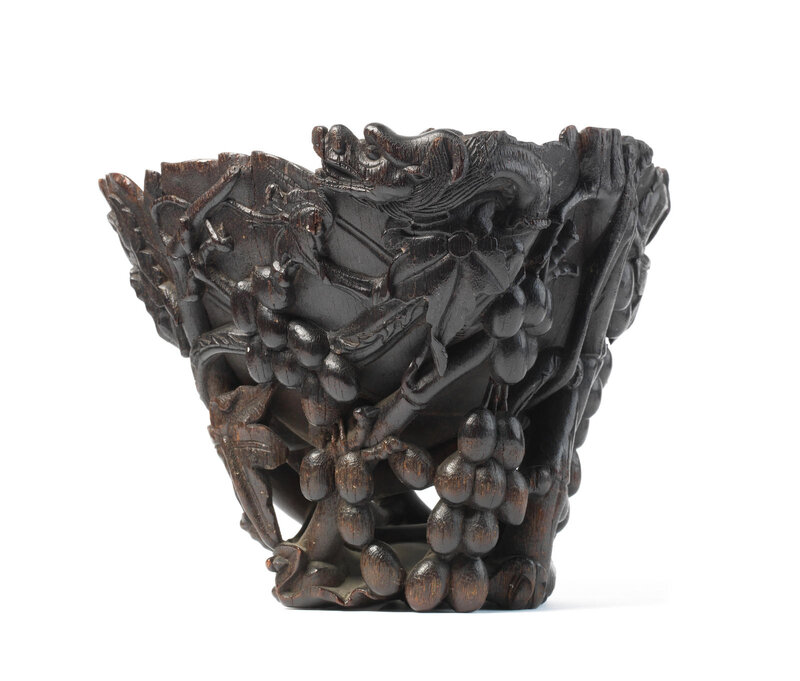

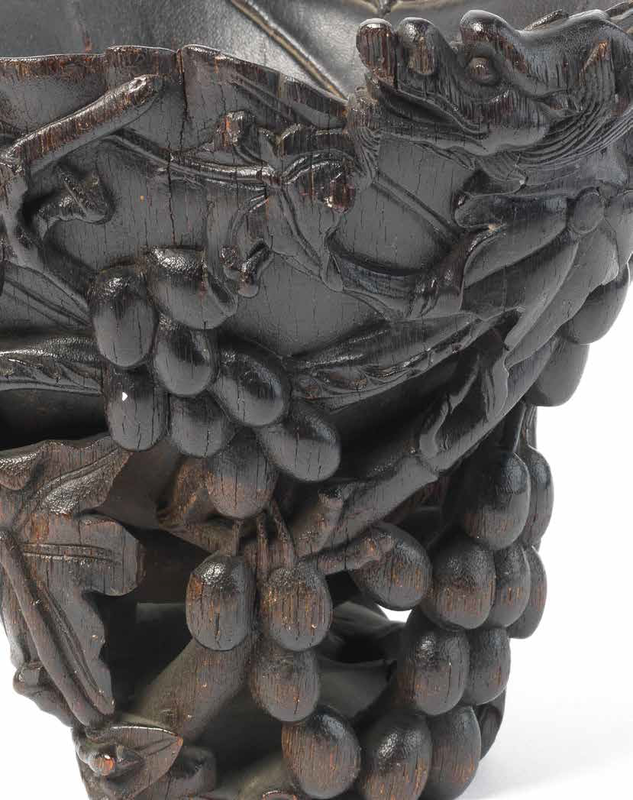
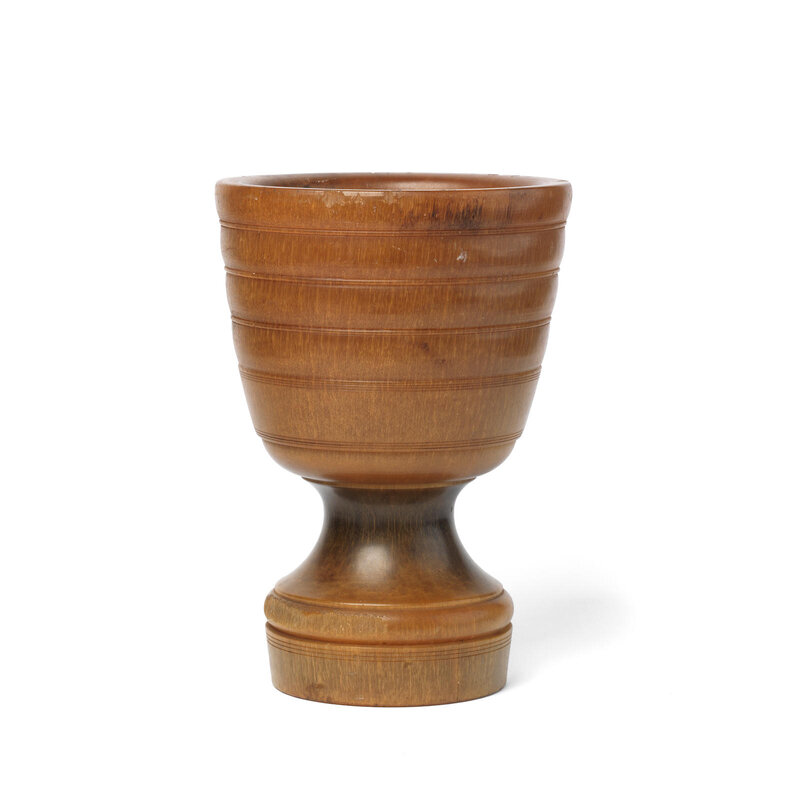


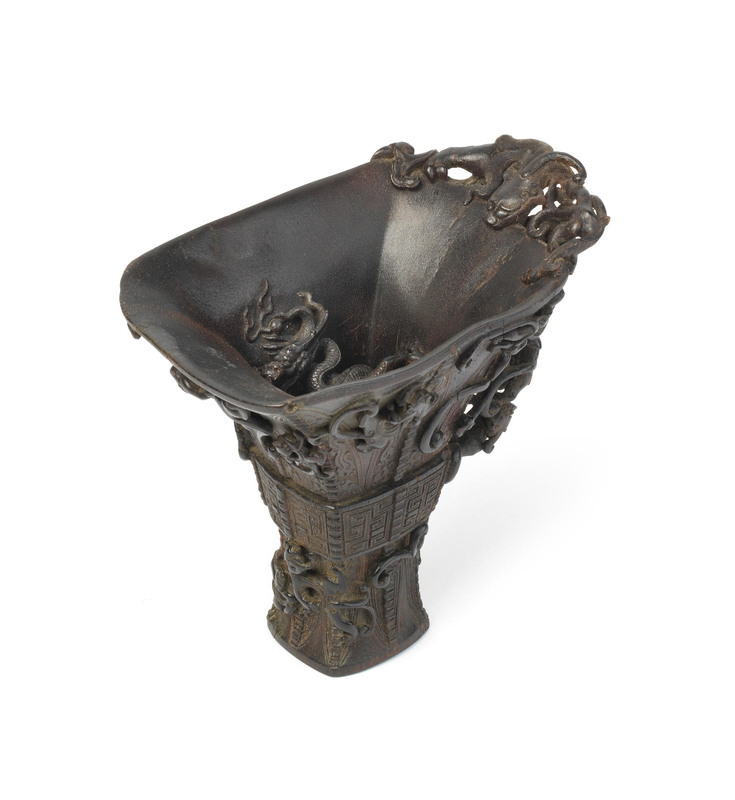





/image%2F1371349%2F20240423%2Fob_b2fe42_telechargement-9.jpg)
/image%2F1371349%2F20240423%2Fob_af8bb4_telechargement-6.jpg)
/image%2F1371349%2F20240423%2Fob_b6c4a6_telechargement.jpg)
/image%2F1371349%2F20240423%2Fob_981d5f_h22891-l367411650-original.jpg)